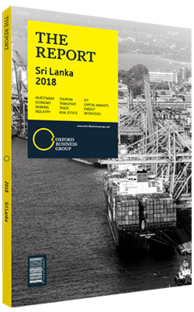More moderate lending growth forecast for Sri Lanka's banks due to stricter monetary policy
Following several years of high credit growth, lending in Sri Lanka slowed in 2017 on the back of stricter monetary policies and higher interest rates. While credit growth is not forecast to reach the peak levels seen between 2015 and 2016, it is expected to rise moderately from 2018 to 2020 thanks to renewed GDP growth and better credit quality.
Cooling Off
Private sector credit soared to 25% in 2015 and 22% in 2016 as a result of government efforts to stimulate the economy. Since then, lending moderated to an estimated 16% in 2017, with this number expected to remain steady in 2018, before rising slightly to a respective 17% and 18% in 2019 and 2020, according to by investment bank First Capital Holdings.
The reduction in credit growth was caused by a number of factors, including the Central Bank of Sri Lanka (CBSL) moving to curb inflationary pressures. The CBSL increased both its standing deposit rate and its standing lending rate by 25 basis points in March 2017, bringing them to 7.25% and 8.75%, respectively, though the deposit rate stood at 8.25% as of March 2018.
In addition to interest rate growth, Sri Lanka’s banks found expanding their loan books a challenge due to tax hikes implemented in early 2017, according to a report issued by ratings agency Fitch in mid-2017.
Banks also generally did well in reducing their rates of non-performing loans (NPLs) in 2017 as the economy recovered. While Sri Lanka faced a wider economic slowdown, with growth easing marginally in 2016 to 4.29%, down from 4.78% in 2015 and 4.87% in 2014, according to IMF figures, the economy picked up to 4.70% in 2017. Economic expansion has been forecast to grow by 4.8%, 4.9% and 5% in 2018, 2019 and 2020, respectively. Across the banking sector as a whole, NPLs are expected to remain at around 4% in 2018.
Uneven Spread
However, the effects of such aggressive lending undertaken in 2015-16 are still a cause for concern, with fears that bubbles have developed in certain sectors. Indrajit Coomaraswamy, governor of the CBSL, voiced the central bank’s suspicion that some credit lines intended as support mechanisms for the development of small and medium-sized enterprises had fed into real estate. Talking to local media in May 2017, Coomaraswamy suggested the bank could move to take macro-prudential measures to slow the property market to put it on a “more sustainable growth path”.
Capital Pressures
Observers have also noted that high dividend payments have reduced capital buffers among some of Sri Lanka’s banks. The three largest banks – the National Savings Bank, Bank of Ceylon and People’s Bank Sri Lanka – paid 76% of their profits as dividends in 2016. Thin capitalisation could take on increased significance as the sector moves towards meeting the requirements of Basel III, which are set to come into effect at the beginning of 2019.
Under the requirements of Basel III, local banks will have to maintain a minimum of 7% in risk-weighted assets (RWAs) under common equity Tier-1 (CET 1); Tier-1 capital of at least 8.5%; as well as total capital (CET 1, additional Tier-1 and Tier-2 capital) of at least 12.5%, up from the current minimum of 10%. Banks designated as systemically important – that is, those with more than LKR500bn ($3.3bn) in assets – will also be required to have an additional buffer of 1.5% in RWAs.
Ratings agency S&P also warned about the risk to capital buffers stemming from high loan growth, which it said could negatively impact banks’ already declining capital levels. “This may further reduce the buffers required to absorb the pain that could come from worsening asset quality,” the agency said in a statement issued at the end of the first quarter of 2017.
New capital reserve requirements mean some banks may also curb their loan activity in the lead up to the 2019 deadline, potentially resulting in falls in revenue and dividends as they shore up their fiscal position at the expense of earnings from lending. However, several banks have turned to rights issues and debentures to meet the incoming requirements (see overview).
You have reached the limit of premium articles you can view for free.
Choose from the options below to purchase print or digital editions of our Reports. You can also purchase a website subscription giving you unlimited access to all of our Reports online for 12 months.
If you have already purchased this Report or have a website subscription, please login to continue.

